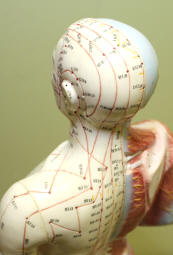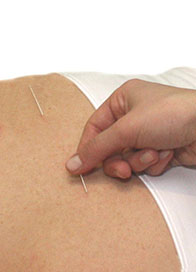
The intent of acupuncture therapy is to promote health and alleviate pain and suffering. Acupuncture is one of the ancient techniques of Traditional Chinese Medicine and has been here for us for thousands of years. Acupuncture and Oriental Medicine comprise a comprehensive medical system that has been used to diagnose, treat and prevent illness for over 3000 years. It is used to relieve pain, strengthen the immune system, heal acute and chronic ailments, and reduce stress and tension.
Oriental medicine is based on an energetic model called Qi. Qi is a vital enery that flows along pathways called meridians which are associated with individual organs.
When the balance of this energy in the meridians is disturbed by injury, poor diet, medications, stress, hereditary conditions, environmental factors or excessive emotional issues, pain or illness results.
Oriental medicine focuses on correcting these energetic imbalances by restoring a free and even flow of Qi, which stimulates the body’s natural ability to heal itself. This is accomplished by stimulating specific points along the meridians with needles or heat.
Modern science has been able to measure the electromagnetic charge at these points and has confirmed the locations and empirical effects of acupuncture points and meridians. As acupuncture works equally well on people as on animals, it does not use the placebo effect as some people believe. Patients do not have to believe in acupuncture for it to work.
The perspective from which an acupuncturist views health and sickness hinges on concepts of "vital energy," "energetic balance" and "energetic imbalance." Just as the Western medical doctor monitors the blood flowing through blood vessels and the messages traveling via the nervous system, the acupuncturist assesses the flow and distribution of this "vital energy" within its pathways, known as "meridians and channels".
Why seek an Acupuncture treatment?
Acupuncture encourages self-care and healthy body awareness. The World Health Organization recognizes acupuncture and traditional oriental medicine’s ability to treat many disorders. The following is a partial list:
- Gastrointestinal Disorders: food allergies, peptic ulcer, chronic diarrhea, constipation, colitis, indigestion, anorexia, gastritis.
- Urogenital Disorders: incontinence, urinary tract infections, sexual dysfunction
- Gynecological Disorders: irregular, heavy or painful menstruation, infertility in women and men, premenstrual syndrome (PMS), menopause, impotence, morning sickness
- Respiratory Disorders: emphysema, sinusitis, asthma, colds, allergies, bronchitis, ear problems
- Musculoskeletal Problems: arthritis, carpal tunnel syndrome, bursitis, tennis elbow, strains and sprains, lower back, neck and shoulder pain
- Circulatory Disorders: low and high blood pressure, chest pains, anemia, edema, and cold extremities
- Emotional and Psychological Disorders: depression, anxiety, stress, fatigue, insomnia, withdrawal from alcohol, nicotine and drugs
- Eye, Ear, Nose and Throat Disorders
- Other: Auto-immune disorders, migraine headaches, dizziness,
- Supportive therapy for other chronic and painful debilitating disorders.
What to expect in an Acupuncture Treatment.

The practitioner asks questions about the body systems at the beginning of each appointment, requiring patients to think about and reflect on the health of their bodies.
Based on the Acupuncture diagnosis, the practitioner inserts tiny needles in specific areas of the body. For the rest of the treatment, patients lie on the table with the needles in and relax, or even fall asleep.
Treatment plans vary by the person and the condition. Patients generally come for acupuncture 1-2 times per week until their symptoms subside, and then either discharge or continue for prevention of illness and health maintenance. An acute or new condition requires a shorter course of treatment and a chronic condition requires a longer course of treatment.
Do you have needle-phobia?
Needle phobia stems from the use of large gauge, hollow needles used to draw blood or inject a substance into the body. Acupuncture needles are different. Unlike hypodermic needles, acupuncture are solid and have polished points instead of beveled sharpened ones, so do not draw blood. A typical acupuncture needle is .20mm in diameter, the thickness of a few human hairs.

